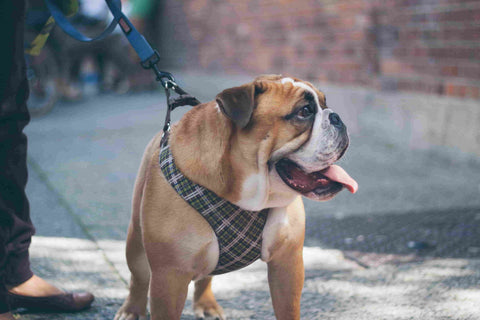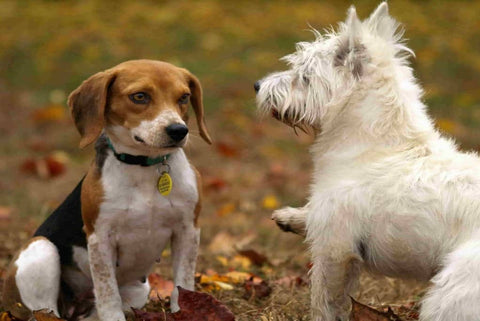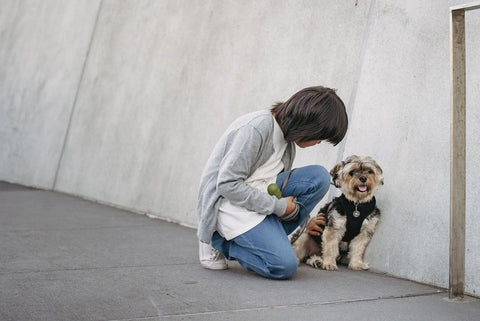Do Front Clip Harnesses Stop Dogs From Pulling?
Maintaining control over your dog during leash training is crucial – and it’s also a huge challenge, especially with a dog that pulls. That’s why more and more dog parents are switching to dog accessories specifically made to discourage your pet from pulling. One of the best options to make your daily walks or leash training sessions easier for you and your four-legged friend is a front clip dog harness. These specialized harnesses work to prevent your dog from pulling, no matter their strength. Keep reading to know everything about how a front clip harness can stop dogs from pulling.
How Front Clip Harnesses Prevent Dogs from Pulling
Front clip harnesses work by giving more control back to you to direct your dog’s movements. Once the harness is put onto the dog, you’ll see a the leash clip at the center of the chest. When you clip the leash here, your dog can’t move ahead of you without being pulled to the side, back towards you. This doesn’t harm the dog; rather, because the leash is clipped to the harness, the pressure is distributed around the body. There is no pain, but there will be enough discomfort to discourage your furry friend from leaving your side.
A front clip dog harness will work well to train your dog not to pull on your daily walks, and with regular, intentional training, you can completely remove the pulling behavior.
Pros and Cons of a Front Clip Dog Harnesses
Unlike traditional harnesses that feature a leash clip on the back, front clip dog harnesses are designed specifically for dogs that tend to pull and run. By squeezing and lifting your dog’s shoulders, the harness creates enough discomfort that the urge to pull completely disappears. It is one of the most effective tools to teach your dog to walk properly so he (and you) can enjoy your walks safely and comfortably.
Here are some other benefits to look forward to with a front clip dog harness.
- Prevent leash-pulling habits, unlike back clip harnesses.
- Provide stability for the dog’s neck compared to traditional collars.
- Easier training for walking, running, hiking, and agility.
Of course, there are limitations to using a front clip dog harness in some situations. Here’s where they may not be ideal for certain dogs.
- Limited function. Like a back clip harness, there is only a single location for the leash.
- Not for regular use. Because of the special shoulder-lifting action, this harness should not be work except during use, unlike collars, which can be worn all the time.
- Not suitable for dogs that tend to choke while wearing a leash or harness. It’s much easier for choking to occur with a front clip harness.
Considering these drawbacks, you might think that a no-pull harness might not work for you. Fortunately, there is a perfect solution: the front and back clip dog harness.
Why You Should Consider a Dual Clip Harness
The front and back clip dog harness, also called a dual clip harness, is the most common type of harnesses that dog parents choose if they want to reduce pulling. It is much more functional and provides superior comfort for both the dog and his person. There are several advantages to choosing a high-quality front and back clip dog harness:
- Versatility. Dual clip dog harnesses have clip locations at the front and the back, which gives you the control you need, when you need it for different activities like walking, running, climbing, or training.
- Safety. Once your dog successfully beats his pulling urges, you can move the leash to the back clip alone so there isn’t any undue pressure on your dog’s chest or ribs. This isn’t an option with a front clip harness.
- More economical. Instead of having a huge collection of harnesses for different purposes, you only need to purchase one dual clip dog harness that suits any activity.
- Comfort. If your dog doesn’t feel comfortable in a harness, he’ll fight putting it on every time. And once your dog has learned not to pull by using the front clip location, he’ll want to be comfortable in a harness that doesn’t cause pressure. All you have to do to maximize his comfort is move the leash clip to the back location.
As you can see, a dual clip dog harness is the perfect alternative to a front clip harness. It’ll save you money in the long run and increase the success of your training sessions.
What is the Best Dual Clip Dog Harness?
Getting any old front and back clip dog harness won’t cut it. Instead, you need to focus on the overall quality of the harness in addition to its multiple clip locations. The best front clip dog harness will have these features:
- The right materials. The harness should be made of material that is soft, flexible and breathable to increase comfort and prevent rashes, rubbing, and excessive sweating.
- Lightweight. A heavy harness quickly leads to exhaustion and chafing. Look for harnesses that feature lightweight materials.
- Easy to use. The harness should be intuitive and easy to put on your dog quickly and conveniently.
- Reflective straps. This feature will ensure your dog’s safety by making him more visible to drivers, cyclists, and pedestrians during early morning or late evening walks.
- Size adjustable. This is the most important thing to look for to make sure your dog is safe, secure, and comfortable during any activity. It is crucial that you ensure the best harness fit for your dog by choosing the right size and making sure that the harness is adjustable.
How to Choose the Right Size Harness
Selecting the right size is the most vital aspect of a harness that dog parents need to check before clicking the “order” button. An incorrectly sized harness can at best negatively impact the dog’s attitude toward training, but it can also cause serious injuries, health problems, and bad behavior. It can also allow dogs to slip out of the harness and run away.
To pick the right size for your dog’s new harness, you first need to take his measurements. Here’s what to measure:
- Neck girth. Measure around the base of the neck.
- Belly girth. Measure an inch or so in front of the rear legs.
- Body length. Measure from just behind the front legs to just behind the rear legs.
Once you have your measurements, check out our dog harness sizing chart and pic the size that matches the measurements.
Tips for Achieving the Perfect Fit
Making sure the harness fits correctly can be challenging, so here are a couple tips to help you out.
#1: If your dog’s measurements fall between two sizes, choose the larger size. Make sure to choose the size based on your dog’s measurements, and not sizes they’ve worn previously in other accessories.
#2: To make sure the fit is correct, slip two fingers under various straps. If you can’t, it is too tight. Then, try to pull the harness over the dog’s head. If it comes off, the harness is too loose.
Get the Best Dual Clip Harness for Your Dog at Pet&Cuddle!
Getting the right harness for dogs that tend to pull is a difficult feat. If you’re ready to help your dog break his pulling habit, a multiple clip dog harness will certainly come in handy. However, along with a no-pull function, you also need to ensure that the dog harness is comfortable, functional, secure, and well-fitting.
As pet experts, we at Pet&Cuddle understand just how hard it can be to get the right accessories for your dog’s specific needs. That’s why we create premium dog products for all breeds, styles, and purposes. From harnesses to leashes, our experienced team knows just what it takes to make products that owners and their four-legged friends love. Our safe, comfortable, and easy-to-use dual clip harnesses feature a unique design suitable for any training or exercising activity.
Check out our latest products for dogs here!
Questions About Front Clip Dog Harnesses
If you have questions about front clip dog harnesses, you aren’t alone. Find answers to the most common questions below:
Are front clip harnesses bad for dogs?
As long as you choose the right size and adjust the harness properly, a front clip harness won’t cause harm to your dog’s health. The lifting and squeezing of the shoulders that the harness does when your dog pulls only causes slight discomfort to discourage pulling.
How does a front clip harness work?
With the D-ring located at the center of the dog’s chest, front clip dog harnesses feature a unique design specifically for dogs who tend to pull. By squeezing and lifting your dog’s shoulders, pulling is easily minimized, due to the discomfort.
How to put on a front clip harness?
A front or dual clip harness fastens like most traditional harnesses. Simply make sure that the D-ring is located at the dog’s chest once the harness is put on. Depending on the model you have, you might need to pull the neck hole of the harness over your dog’s head or place the dog’s front paws into the loops of the harness and pull it up. Whichever type you have, make sure to adjust as needed.
How to adjust a front clip dog harness?
When you adjust the harness straps, you should hear a click that indicates when it has been put on correctly. To make sure it fits well, try to pull the harness over your dog’s head to make sure it is firm and secure. Then, use the two-finger test by slipping two fingers underneath any given strap on the harness. Loosen or tighten as needed.




